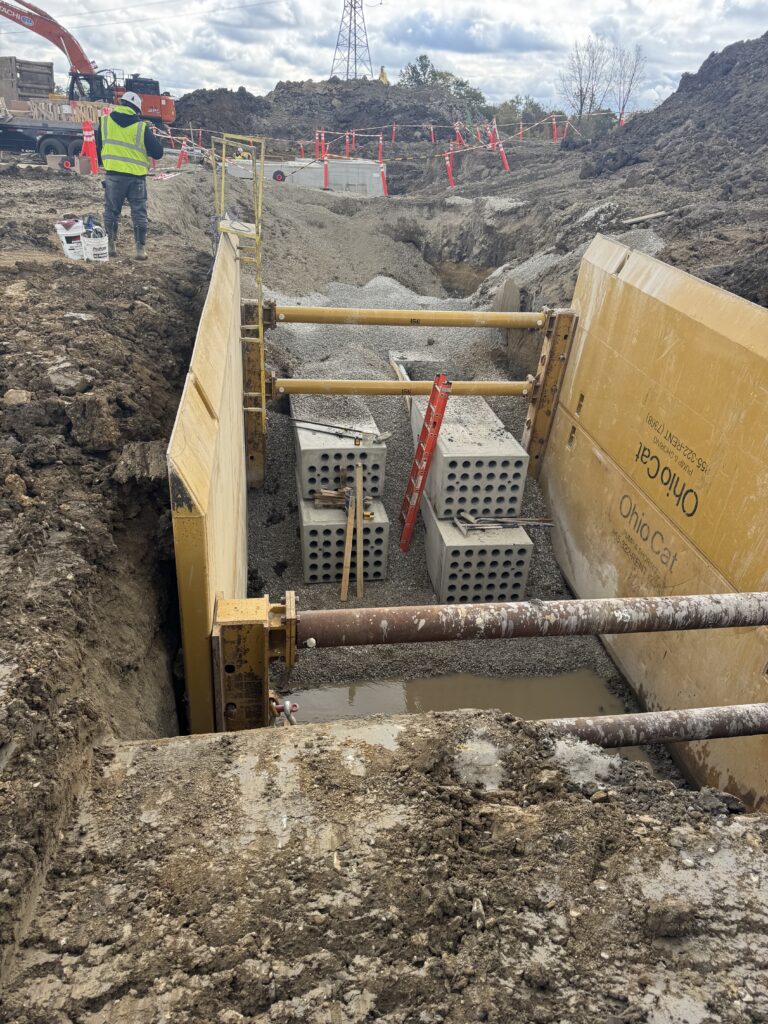When electrical contractors hear “precast,” the first question is almost always the same:
“If it’s built off-site, what’s left for us to do?”
We get it. Every EC has seen prefab scopes eat into field hours somewhere else. That’s not what we do at DBO. We’re here to make your team faster, safer, and more profitable — not replace them. We don’t do the work — we make sure you own it safely and efficiently. That’s how ECs keep full control of their scope while reducing the uncertainty that eats margin.
What ECs Actually Gain with Precast
Traditional cast-in-place duct banks consume your most valuable resource: skilled electricians.
Every hour those electricians spend in a trench tying conduit or waiting on inspections is time they’re not doing the high-value work your margins depend on.
DBO’s process shifts that time from manual labor to measurable productivity.
Here’s how:
- Your crew installs finished sections — no rebar, no formwork, no pour management.
- Trench exposure drops from days to hours, freeing labor for terminations, gear install, and commissioning.
- QC documentation arrives pre-stamped — no field tests, no inspection holds.
You keep control of the scope. We help you complete it faster.
Training That Protects Profit
Every EC that works with us goes through hands-on training before their first install. Whether it’s at our Training Facility or directly on-site, our team walks your foremen and operators through the full process:
- Rigging and setting sections safely.
- Using guided dowel pins for alignment (no hands between pieces).
- Sealing joints and preparing for inspection.
- Backfill and compaction techniques for same-day closure.
Crews leave knowing how to run the work efficiently — not learning it midstream.
The result:
- Faster ramp-up.
- Fewer callbacks.
- Protected labor budgets.
When your electricians aren’t stuck in the trench, your bid hours stretch further across the project.
How Training Pays Off in the Field
Real project results tell the story better than we can. One electrical contractor client completed DBO’s training ahead of a large-scale utility expansion. By the time their crew hit the site, every operator understood the dowel-pin system and trench-prep requirements.
The results were immediate:
- First-day sets averaged about 10 minutes per section.
- By the end of the first week, sections were installing in under 5 minutes.
- The crew achieved bid-day efficiencies by day three and stayed ahead of schedule for the remainder of the project.
Across other projects, trained EC crews routinely cut trench exposure from multiple days to a single shift — same electricians, same equipment, less idle time. That’s what happens when training eliminates the learning curve before the first trench opens.
On-Site Support That Keeps Crews Confident
DBO doesn’t just deliver product and walk away. Our technical field representatives stay with your crew through the first installation, ensuring everyone’s comfortable with alignment, rigging, and sealing. If questions come up later, we’re a call away for remote guidance or refresher sessions.
You install it. We just remove the risk. DBO eliminates weather delays, schedule slip, and the uncertainty that kills margin — while ECs keep every bit of their scope.
Why ECs Keep Partnering with DBO
We’ve trained hundreds of electricians, foremen, and operators across data-center, industrial, and utility projects — and the pattern is always the same:
- Reduced field hours without reducing billable scope.
- Improved safety metrics through hands-free alignment.
- Predictable productivity that protects bid performance.
That’s why our repeat contractors keep DBO on their preferred vendor lists — because we protect what matters most: their schedule, their labor, and their reputation.
How We Keep You Building
Precast doesn’t take work away from electrical contractors — it takes the risk out of it. DBO’s training, field support, and documentation give ECs the confidence to install faster and safer, without losing control of their scope. When your crews are trained, your hours hold, and your project stays ahead — that’s not scope loss. That’s smarter construction.



